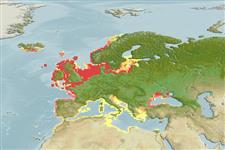Preferred temperature (Fonte Biblio.
123201): 5.9 - 11.9, mean 9.4 °C (based on 239 cells).
Phylogenetic diversity index (Fonte Biblio.
82804): PD
50 = 0.5645 [Uniqueness, from 0.5 = low to 2.0 = high].
Bayesian length-weight: a=0.01122 (0.00922 - 0.01365), b=3.06 (3.00 - 3.12), in cm total length, based on LWR estimates for this species (Ref.
93245).
Trophic level (Fonte Biblio.
69278): 4.4 ±0.0 se; based on diet studies.
Generation time: 4.8 (3.8 - 5.8) years. Estimated as median ln(3)/K based on 24
growth studies.
Resilienza (Fonte Biblio.
120179): Medio, tempo minimo di raddoppiamento della popolazione 1.4 - 4.4 anni (K=0.15-0.28; tm=3-5; tmax=26; Fec=5 million).
Prior r = 0.50, 95% CL = 0.33 - 0.75, Based on 9 full stock assessments.
Fishing Vulnerability (Ref.
59153): High vulnerability (60 of 100).
🛈
Climate Vulnerability (Ref.
125649): High vulnerability (65 of 100).
🛈
Nutrients (Ref.
124155): Calcium = 28.5 [12.1, 48.8] mg/100g; Iron = 0.144 [0.058, 0.649] mg/100g; Protein = 19.5 [18.0, 21.0] %; Omega3 = 0.275 [0.153, 0.500] g/100g; Selenium = 14.1 [6.4, 33.9] μg/100g; VitaminA = 8.19 [2.10, 35.13] μg/100g; Zinc = 0.156 [0.092, 0.524] mg/100g (wet weight); based on
nutrient studies. 